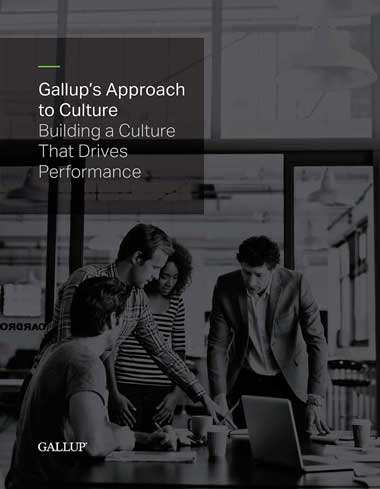Story Highlights
- Hiring for a culture fit can unwittingly encourage unconscious bias
- It's time we stop trying to "fit" new hires to the organizational culture
- Culture add -- a new spin on culture fit -- celebrates diversity and talent
I spend a lot of time talking to clients about their hiring practices and see the extreme variability in how different organizations understand and approach hiring decisions. Recently, in discussions with employees at a factory of a Gallup client, a machinist grumbled to me, "We never get to have a say in who gets hired. They just show up and sit next to us, often not being able to get along." When asked what they would look for if involved in the hiring process, I heard, "A good sense of humor. Having easy banter with the rest of us - fitting in, you know!"
After the conversation, the HR Lead at the factory confessed to me that they disliked this notion of needing good "banter" in the workplace, saying it was used as a front to thinly veil expressed misogyny and racism. The HR Lead believed the idea of "culture fit" was ridden with biases and that the organization needed "culture add." I agreed and shared examples of how some of my clients have positively made this change to further their diversity and inclusion ambition. I also worked to align hiring practices with employee talents and aspirations.
Culture fit is the idea of recruiting individuals whose value systems, beliefs and everyday behaviors align well with the hiring organization's to help keep the culture intact.
While this might seem reasonable and harmless, hiring decisions based on an individual's perception of culture fit can be unfair and influenced by unconscious bias.
Culture add is a fresh spin on the concept of culture fit. Rather than making hiring decisions that create a homogenous, familiar culture, culture add promotes hiring decisions that focus on candidates' unique and beneficial attributes, values, beliefs and behaviors. It is what they bring to your organization from their distinct perspective and experiences.
Rather than making hiring decisions that create a homogenous, familiar culture, culture add promotes hiring decisions that focus on candidates' unique and beneficial attributes, values, beliefs and behaviors.
Hiring for Culture Fit Often Falls Short of Being Fair
Hiring for culture fit assumes that the hiring decision-maker understands and role models organizational values, beliefs and expected behaviors used to define the culture and can make a fair, informed selection decision.
However, decision-makers often come with their own values and beliefs that may not align with the organization's. Hiring techniques like "airport tests" - hypothesizing about whether you would want to be stuck in an airport with this person - and other arbitrary methods to gauge culture fit are often subject to first-impression bias and confirmation bias. And this is the sort of bias that hiring for talent can avoid.
The lack of culture fit is a leading reason for turning down candidates and letting go of probationary employees. But because of its subjective and ambiguous nature, "you don't fit in with the culture" typically isn't useful feedback to help candidates or employees improve, resulting in an unpleasant exit experience.
In today's marketplace conditions, where 51% of currently employed workers say they are actively looking for a new job or watching for job openings, employees are the "consumers of the workplace," and negative experiences at any stage of the employee journey jeopardize the employer brand.
Hiring for Culture Fit Requires Cultural Maturity
Hiring for culture fit assumes a level of maturity in an organization's culture journey, including a fair amount of awareness and training. However, the reality today is that about two in 10 employees strongly agree they feel connected to their organization's culture.
When an organization's expected value systems, beliefs and behaviors are aspirational rather than lived and practiced, hiring for culture fit becomes challenging. It's demanding because often decision-makers themselves are not a "fit" to the desired culture, making the process appear hypocritical with selection decisions feeling inauthentic.
Remote and hybrid work has future complicated the possibility of culture add, with a large part of workers' connections coming primarily through technology.
Part of the solution could be culture add or revising the concept of culture fit. Rather than making hiring decisions that create a culture of homogeneity and familiarity, culture add promotes hiring decisions that focus on candidates' unique and beneficial attributes, values, beliefs and behaviors, making it possible for organizations to add valuable elements to their culture that it lacks. Culture add celebrates diversity and acknowledges that the organizational culture is in a constant state of improvement.
The fundamental need, however, is for organizations to recognize what they are hiring for and why it matters. The right hiring practices examine not only cultural needs, value systems and technical competence but also factor in role-specific talent attributes and behaviors that account for high performance.
The right hiring practices examine not only cultural needs, value systems and technical competence but also factor in role-specific talent attributes and behaviors that account for high performance.
At Gallup, our research on talent explores patterns and tendencies of high performers in each role. Organizations that hire applicants recommended by Gallup's talent-based assessments tend to realize 10% higher productivity, 30% higher profitability and 10% lower employee turnover, in addition to other business outcomes.
In fact, Gallup advisory and tools help clients focus their hiring process on what it takes to get high performance while enabling diversity.
Simply put, it's better for employers to stop trying to fit employees or hiring candidates to the workplace culture. Instead, they should add to the workplace culture by adjusting hiring practices to align with employee talents, competence and aspirations.
Build an organizational culture you can be proud of:
- Learn the four keys to culture transformation.
- Find out why organizational culture is important.
- Discover the power of building a strengths-based culture.





